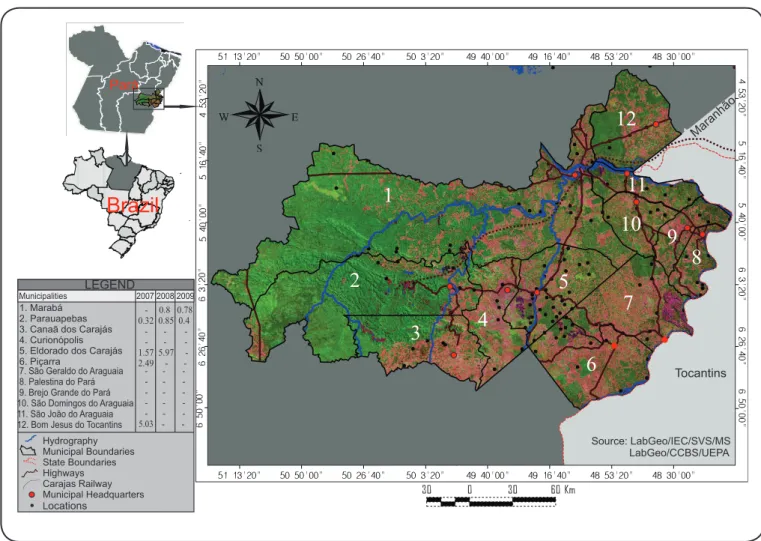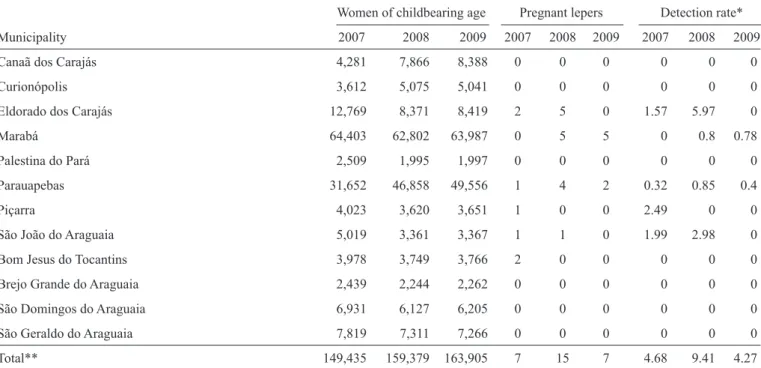650
Address to: Dra. Vera Regina da Cunha Menezes Palácios. Travessa Rui Barbosa 619/1102, Bairro do Reduto, 66053-260 Belém, PA, Brasil.
Phone: 55 91 9983-3013.
e-mail: verareginapalacios@gmail.com Received 20 November 2011 Accepted 19 February 2012
Analysis of the detection coeffi cient for the association
between leprosy and pregnancy in the integration
region of Carajás, State of Pará, Brazil
Vera Regina da Cunha Menezes Palácios
[1], Cléa Nazaré Carneiro Bichara
[1],
Rodrigo da Silva Dias
[1], Alcinês da Silva Sousa Júnior
[2], Renan Faria Cardoso
[3],
Glaubus Vinicius Neves Barreiros
[2]and Nelson Veiga Gonçalves
[1],[2],[4][1]. Departamento de Saúde Comunitária, Universidade do Estado do Pará, Belém, PA. [2]. Laboratório de Geoprocessamento, Instituto Evandro Chagas, Ananindeua, PA. [3] Curso de Medicina, Universidade do Estado do Pará, Belém, PA. [4]. Laboratório de Geoprocessamento, Universidade do Estado do Pará, Belém, PA.
ABSTRACT
Introduction: The association between leprosy and pregnancy is currently poorly understood and has been linked to serious clinical consequences. Methods: A retrospective study between 2007 and 2009 was performed in the integration region of Carajás, Brazil on a population of pregnant lepers, with non-lepers of ages 12-49 years serving as the reference population. Results: Twenty-nine pregnant lepers were studied during the study period. The detection rates (DRs) for the studied association were 4.7 in 2007, 9.4 in 2008, and 4.3 in 2009. Conclusions: The Carajás region presented a medium pattern of endemicity during most of the study period, with a high DR found in 2008.
Keywords: Leprosy. Pregnancy. Epidemiology.
According to the World Health Organization (WHO), 244,796 cases of leprosy were detected in 2009, which represents a decreased detection rate since 20031.
The WHO currently uses an operational classifi cation to
register leprosy cases based on clinical and bacteriological indices2,3. According to the Jopling classifi cation (1966), leprosy
reactions are divided into type I (reverse) and type II reactions and are present in 10-50% of cases, especially in multibacillary forms, thus constituting a risk factor for disability4.
In Brazil, data on leprosy during pregnancy have only been reliably available since 2007 from the Information System for
Notifi able Diseases (SINAN)5,6, which reduces and limits the
data that can be analyzed.
During pregnancy, cellular immunity is suppressed, particularly in the last quarter of pregnancy. Additionally, in the puerperium phase, humoral immunity is suppressed, which explains why pregnant women are more susceptible to infections, such as hepatitis and toxoplasmosis7-9.
Leprosy reactions may arise before, during, or after leprosy treatment9. Type II reactions occur mainly in the last trimester of
pregnancy and may even lead to Lucio's phenomenon (necrotizing vasculitis)8,10. This study aimed to analyze the association between
leprosy and pregnancy, as well as update the epidemiological records of this interaction, using the current methods of data collection for the generation of detection rates (DRs). The objective was to review the process of data generation.
To achieve this aim, we performed a retrospective investigation of the DRs for the period of 2007 to 2009, in the integration region of Carajás, State of Pará, Brazil (Figure 1), after applying the formula for calculating the DR of the number of cases of leprosy in pregnant subjects by region of integration in Pará (Table 1). To calculate the DRs of leprosy associated with pregnancy, the number of pregnant leper women was divided by the size of the female population between 12 and 49 years of age (childbearing age) and multiplied by 100,000. The coefficient generated allowed us to analyze the strength of the association between leprosy and pregnancy, as well as its magnitude and trend. As the Carajás region showed the highest DRs, we performed a detailed analysis of its municipalities (Table 2). The collection of variables of interest related to the study population and reference population was performed from data provided by the Department of Informatics of SUS (DATASUS), as well as from data on the
SINAN notifi cation forms and on the population database from
the Brazilian Institute of Geography and Statistics (IBGE). Because there is no suitable parameter for the association
between leprosy and pregnancy, the signifi cance of the observed DRs was assessed by comparing the DR fi ndings with the overall
detection rate recommended by the Ministry of Health (MS)11,12.
Specifically, for every 100,000 inhabitants, hyperendemic
indicates greater than or equal to 40 cases, very high indicates 20-39 cases, high indicates 10-19 cases, medium indicates 2-9 cases, and low indicates less than 2 cases.
Revista da Sociedade Brasileira de Medicina Tropical 46(5):650-653, Sep-Oct, 2013
http://dx.doi.org/10.1590/0037-8682-1459-2013
651
Palácios VRCM et al - Association between leprosy and pregnancy in Carajás, Pará, Brasil
TABLE 1 - Detection rates for the association between leprosy and pregnancy by integration region, State of Pará, Brazil, between 2007 and 2009.
2007 2008 2009
Integration region LP P DR LP P DR LP P DR
Araguaia 4 109,780 3.64 8 126,991 6.30 7 130,121 5.38
Baixo Amazonas 2 185,257 1.08 4 184,925 2.16 - 186,914 0.00
Caetés - 124,819 0.00 2 124,845 1.60 - 126,637 0.00
Capim 14 165,284 8.47 6 161,876 3.71 5 165,103 3.03
Carajás 7 149,435 4.68 15 159,379 9.41 7 163,905 4.27
Guamá 1 171,003 0.58 1 171,187 0.58 2 174,029 1.15
Lago de Tucuruí 3 100,453 2.99 2 97,540 2.05 5 99,716 5.01
Marajó 2 105,758 1.89 2 114,209 1.75 4 117,043 3.42
Metropolitana 7 712,772 0.98 2 696,525 0.29 3 707,114 0.42
Tapajós 4 69,701 5.74 3 75,396 3.98 - 77,492 0.00
Tocantins 15 186,595 8.04 3 195,679 1.53 5 200,418 2.50
Xingu 2 93,078 2.15 6 95,755 6.27 01 97,473 1.03
LP: number of leper pregnants; P: female population between 12 and 49 years old; DR: detection rate of the number of cases. *Per 100,000 inhabitants.
Source: Departamento de Informática do Sistema Único de Saúde (DATASUS) and Instituto Brasileiro de Geografi a e Estatística (IBGE).
Pará
Brazil
1
2
3
4
5
6
7
8
9
10
11
12
Source: LabGeo/IEC/SVS/MS LabGeo/CCBS/UEPA Maranhão
Tocantins LEGEND
1. Marabá 2. Parauapebas 3. Canaã dos Carajás 4. Curionópolis 5. Eldorado dos Carajás 6. Piçarra
Municipalities 2007 2008 2009
7. São Geraldo do Araguaia 8. Palestina do Pará 9. Brejo Grande do Pará 10. São Domingos do Araguaia 11. São João do Araguaia 12. Bom Jesus do Tocantins
- 0.8 0.78 0.32 0.85 0.4
1.57 5.97 2.49 5.03
-Hydrography Municipal Boundaries State Boundaries Highways Carajas Railway Municipal Headquarters Locations
652
Rev Soc Bras Med Trop 46(5):650-653, Sep-Oct, 2013
REFERENCES
The authors declare that there is no confl ict of interest.
CONFLICT OF INTEREST ACKNOWLEDGMENTS
TABLE 2 - Number of women of childbearing age, number of cases of pregnant lepers, and the detection rates by municipality in Carajás, State of Pará, Brazil.
Women of childbearing age Pregnant lepers Detection rate*
Municipality 2007 2008 2009 2007 2008 2009 2007 2008 2009
Canaã dos Carajás 4,281 7,866 8,388 0 0 0 0 0 0
Curionópolis 3,612 5,075 5,041 0 0 0 0 0 0
Eldorado dos Carajás 12,769 8,371 8,419 2 5 0 1.57 5.97 0
Marabá 64,403 62,802 63,987 0 5 5 0 0.8 0.78
Palestina do Pará 2,509 1,995 1,997 0 0 0 0 0 0
Parauapebas 31,652 46,858 49,556 1 4 2 0.32 0.85 0.4
Piçarra 4,023 3,620 3,651 1 0 0 2.49 0 0
São João do Araguaia 5,019 3,361 3,367 1 1 0 1.99 2.98 0
Bom Jesus do Tocantins 3,978 3,749 3,766 2 0 0 0 0 0
Brejo Grande do Araguaia 2,439 2,244 2,262 0 0 0 0 0 0
São Domingos do Araguaia 6,931 6,127 6,205 0 0 0 0 0 0
São Geraldo do Araguaia 7,819 7,311 7,266 0 0 0 0 0 0
Total** 149,435 159,379 163,905 7 15 7 4.68 9.41 4.27
*Per 100,000 inhabitants; **Detection rate calculated relative to the entire region of Carajás.
The authors thank Mr. Sebastião Alves de Sena Neto
(Sistema Nacional de Agravos de Notifi cação/MS) for his
invaluable help with this research.
1. World Health Organization (WHO). Weekly Epidemiological Record [Internet]. Geneva: WHO; 2010 August 27 [Cited 2010 December 25]. p. 337-348. Available from: http://www.who.int/wer/2010/wer8535/ en/index.html
2. Lockwood D. Leprosy. BMJ [Internet]; 2007. [Cited 2010 September 15]. Available from: http://clinicalevidence.bmj.com/ceweb/conditions/ ind/0915/0915_backgr.jsp/
3. Croft RP, Smith WCS, Nicholls P, Richardus JH. Sensitivity and specifi city of methods of classifi cation of leprosy without use of skin-smear examination.
Int J Lepr Other Mycobact Dis 1998; 66:445-450.
4. Teixeira MAG, Silveira VM, França ER. Características epidemiológicas e clínicas das reações hansênicas em indivíduos paucibacilares e multibacilares
According to the general parameter for the DRs studied, the following results were obtained, as detailed in Table 1:
high (Carajás in 2008), medium (Araguaia every year, Baixo Amazonas in 2008, Capim every year, Carajás in 2007 and 2009, Lago de Tucuruí every year, Marajó in 2009, Tapajos in 2007 and 2008, Tocantins in 2007 and 2009, and Xingu in 2007 and 2008), and low (Caetés, Guamá, and Metropolitana in all years). The Carajás region presented a medium pattern of endemicity in other years of research.
Because these study data only take into account the size of the female population between 12 and 49 years of age, which is a fraction of the general population, it was observed that the DRs, compared with the parameter recommended by the Ministry of
Health, may not refl ect the actual epidemiological situation of
the studied interaction. Therefore, it was necessary to identify a more appropriate parameter, such as the parameter used for children under 15 years of age, which is also a population fragment.
The analysis shows that the region of Carajás had the highest DR in the State of Pará, ranging from medium to high throughout the study period. Considering the differentiated demographic and socioeconomic characteristics of this region, a spatial trend analysis will be carried out throughout this
ongoing study to better understand the social infl uences on the
association between leprosy and pregnancy. After this analysis was performed, the need for identifying a new parameter for assessing the DR of pregnant lepers was realized, as neither the general population size nor the number of children under 15 years of age proved to be adequate. The number of pregnant women affected by leprosy is much lower than the general
653 atendidos em dois centros de referência para hanseníase, na cidade de Recife,
Estado de Pernambuco. Rev Soc Bras Med Trop 2010; 43:287-292. 5. Galvão PRS, Ferreira AT, Maciel MGG, Almeida RP, Hinders D, Schreuder
PA, et al. Uma avaliação do sistema de informação SINAN usado no Programa de Controle de Hanseníase no estado do Pernambuco, Brasil. Cad Saúde Coletiva 2009; 17:87-102.
6. Ministério da Saúde. Portal da Saúde. Hanseníase - Casos confi rmados notifi cados no Sistema de Informação de Agravos de Notifi cação [Internet].
Brasília: Departamento de Informática do SUS; 2009 [Cited 2010 September 12]. Available from: http://dtr2004.saude.gov.br/sinanweb/ tabnet/dh?sinannet/hanseniase/bases/Hansbrnet.def/
7. Lockwood DN, Sinha HH. Pregnancy and leprosy: a comprehensive literature review. Int J Lepr Other Mycobact Dis 1999; 67:6-12. 8. Helmer KA, Fleischfresser I, Kucharski-Esmanhoto LD, Fillus Neto J,
Santamaria JR. Lucio’s phenomenon (necrotizing erythema) in pregnancy. An Bras Dermatol 2004; 79:205-210.
9. Ministério da Saúde. Brasil reduz casos de hanseníase em menores de 15 anos. SVS em rede [Internet]. Brasília: Secretaria de Vigilância em Saúde; 2010 [Cited 2010 September 12]. Available from: http://189.28.128.179:8080/ svs_informa/edicao-69-janeiro-de-2010/brasil-reduz-casos-de-hanseniase-em-menores-de-15-anos/
10. Rodríguez-Pazos L, Gómez-Bernal S, Sánchez-Aguilar D, Toribio J. Lepra
Reaction and Pregnancy. Actas Dermosifi liogr 2010; 101:190-191.
11. Ministério da Saúde, Secretaria de Vigilância em Saúde, Departamento de Vigilância Epidemiológica. Programa Nacional de Eliminação da Hanseníase. In: Ministério da Saúde, editor. Hanseníase. Guia de Vigilância Epidemiológica. 7th ed. Brasília: Ministério da Saúde; 2009. p. 1-28.
12. Palácios VRCM, Dias RS, Neves DCO. Estudo da situação da hanseníase no estado do Pará. Rev Para Med 2010; 24:49-56.

